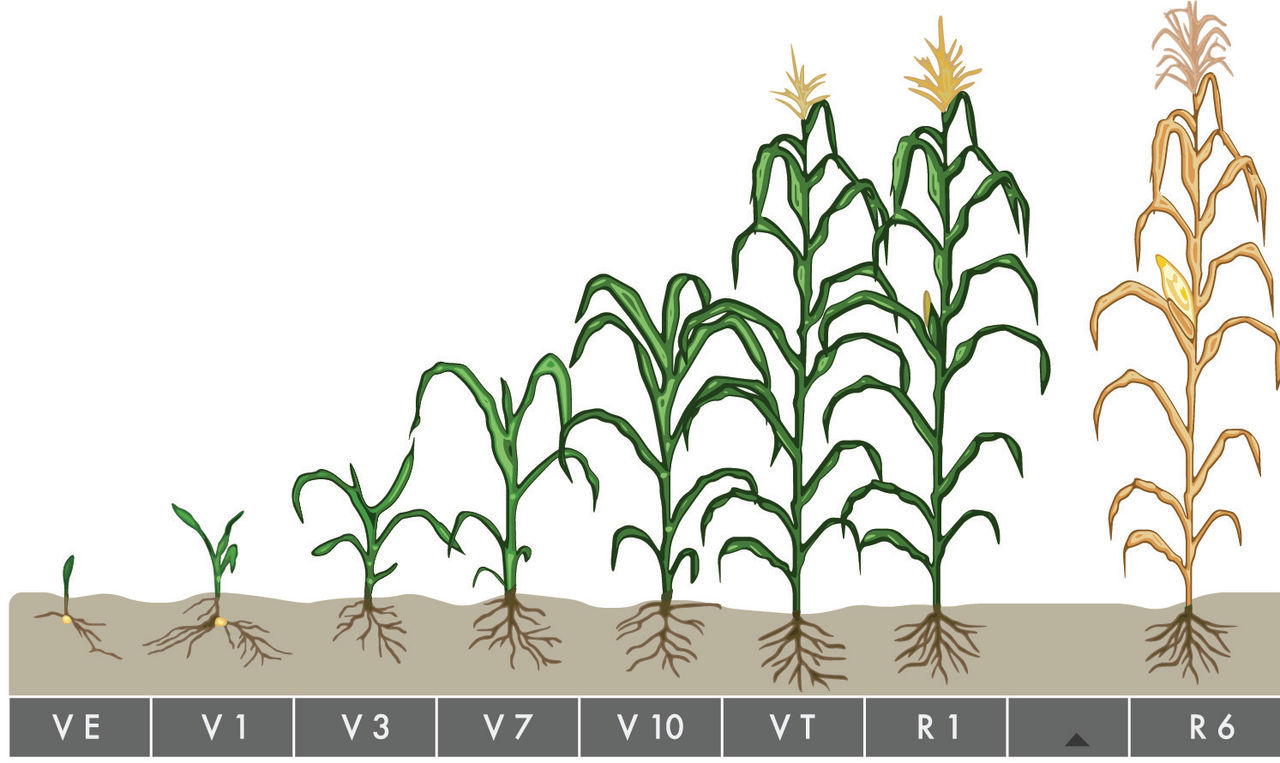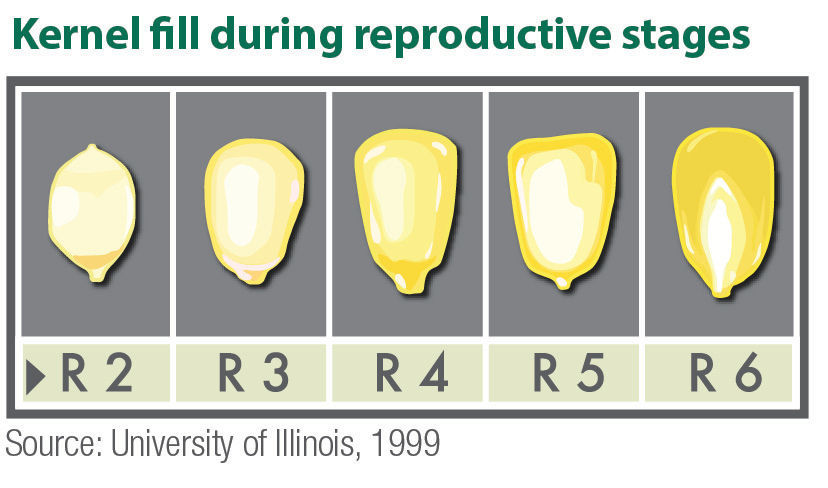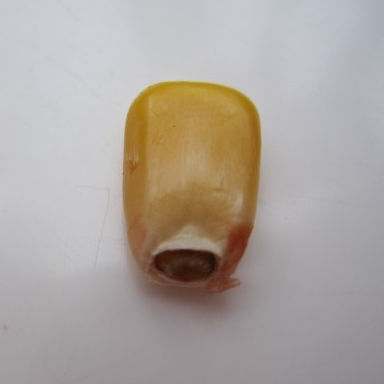7 MIN READ
Determining Corn Growth Stages
October 15, 2020
Corn has two distinct phases of growth: vegetative and reproductive.
Vegetative Growth Stages in Corn
Vegetative stages are identified by the number of collars present on the plant. The leaf collar method is generally used for staging vegetative (V) development of corn. When corn seedlings emerge from the soil and no leaf collars have formed, plants are in the VE stage. When the plant has one visible leaf collar, it is in the V1 stage. The leaf collar is a light-colored band located at the base of an exposed leaf blade, near the spot where the leaf blade meets the stem of the plant. Leaves within the whorl, not fully expanded and with no visible leaf collar, are not included in the staging. For example, a plant with three collars would be called a V3 plant; however, there may be five to six leaves showing on the plant (Figure 1). Corn plants generally develop up to the V18 stage before reaching maximum height at tassel emergence (VT) and transitioning into the reproductive (R) stages of growth.
Beginning at about V6, the lowest leaves may fall from the plant and dissection of the lower stalk may be necessary to accurately stage the plant. To stage older plants, dig up the plant and split the stalk down into the root ball. Find the triangular “woody” base of the stalk and locate the first internode above the base. The woody, horizontal node is the point of attachment for the fifth leaf or collar. For example, if you can count five visible leaf collars above this point, the corn plant is in the V10 growth stage.
For more information on staging corn plants, read the Spotlight, Corn Growth Stage and Herbicide Application.

VE - Can occur 4 to 5 days after planting under ideal conditions, but up to 2 weeks or longer under cool or dry conditions.
V1-V5 - At V1, round-tipped leaf on first collar appears, nodal roots elongate. By V2, plant is 2 to 4 inches tall and relies on the energy in the seed. V3 begins 2 to 4 weeks after VE, and plant switches from kernel reserves to photosynthesis and nodal roots begin to take over. Around V4, broadleaf weeds should be controlled to avoid loss. By V5, the number of potential leaf and ear shoots are determined. Plant is 8 to 12 inches tall and growing point remains below soil surface.
V6-V8 - Beginning 4 to 6 weeks after VE, the growing point grows above the soil surface, increasing susceptibility to hail, frost or wind damage. The nodal root system is dominant. At V7, rapid growth phase and stem elongation begin. Number of kernel rows is determined and potential kernels per row begins and continues through V15/16. By V8, the plant reaches 24 inches tall.
V9-V11 - Around 6 to 8 weeks after VE, corn begins steady and rapid period of growth and dry matter accumulation. At V9, tassel is developing rapidly, but is not yet visible. New leaves appear every 2 to 3 days and ear shoots are developing.
V12-Vnth - By V12, the plant is about 4 feet tall or more. Nutrients and water are in high demand to meet growth needs. All leaves are full size and roughly half are exposed to sunlight. Brace roots are developing and the potential number of kernels per ear and size of the ear are still being determined. Insect and hail injury can reduce the number of kernels that develop. The plant is about two weeks away from silking at V15. The tassel is near full size, but not visible. Moisture and nutrient deficiencies at this time can reduce the number of potential kernels per row resulting in shorter ears and lower yield potential.
VT - Beginning around 9 to 10 weeks after emergence, corn enters a critical period where successful pollination is required to convert potential kernels into viable, developing kernels. The plant has reached full size. Tassels are fully visible and silks will emerge in 2 to 3 days. Pollen shed begins and continues for 1 to 2 weeks. Hail can be very damaging at this stage.
Reproductive Growth Stages in Corn
Corn plants enter reproductive growth after completing tassel emergence. Reproductive growth stages are determined by kernel development and not plant collars.

Corn Growth Stages
R1 Silking - Silking is one of the most critical stages in determining yield potential. For an individual plant it is when the silks are visible. For a field to be in the R1 stage, the average silking date is used. The average silking date is when 50% of the plants have started to silk. Pollination begins at the base and proceeds toward the tip. Potassium uptake is complete, and nitrogen and phosphorus uptake is occurring rapidly. Physiological maturity can be estimated by adding 50 to 55 days to the silking date.
R2 Blister - About 12 days after silking, silks darken and dry out. Kernels are white and form a small blister containing clear fluid. Each kernel develops an embryo. Kernels contain 85% moisture. Stress (especially drought) at this stage can reduce yield potential by causing kernel abortion.
R3 Milk - About 20 days after silking, kernels are yellow and clear fluid turns milky white as starch accumulates. Kernels contain 80% moisture. The effects of stress are not as severe after this stage, but can still result in shallow kernels, stalk cannibalization, or lodging.
R4 Dough - About 26 days after silking, the starchy liquid inside the kernels has a dough-like consistency. Kernels contain about 70% moisture, begin to dent at the top, and have accumulated close to 50% of their maximum dry weight. Stress can produce unfilled or shallow kernels and “chaffy” ears.
R5 Dent - About 38 days after silking, nearly all kernels are dented and contain about 55% moisture. Cob has distinct color: white, pink or red. Silage harvest begins sometime during this stage, depending on desired whole plant moisture.
R6 Black Layer - About 60 days after silking, physiological maturity is reached, and kernels have attained maximum dry weight at 30 to 35% moisture. Total yield is determined, and frost has no impact on yield.

Estimating Corn Growth Stage with Growing Degree Days1,2
Corn growth stages can be estimated using corn growing degree days (GDD) accumulated daily from the date of planting. Corn GDD are calculated by taking the maximum daily temperature plus the minimum daily temperature to determine the average temperature in a 24-hour period. The average temperature is subtracted from the base temperature of 50°F to obtain the corn GDD for the 24-hour period. Corn development slows drastically when the temperature is above 86°F, so when the high temperature exceeds 86°F, it is used as the default high temperature for the day.

Corn generally requires about 82 to 85 GDD from to complete a leaf collar emergence, up to growth stage V10, later vegetative stages only require about 50 GDD for collar emergence. It usually takes 115 to 120 GDD for corn to emerge after planting. Therefore, if a field has accumulated 380 GDD from date of planting, subtracting 115 GDD from 380 GDD equals 265 GDD, so the growth stage estimate for the field would be early V3.
While corn GDD can be used to estimate growth stage, keep in mind that stress factors (especially drought) can influence growth and relying on degree days may not provide an accurate estimation of growth stage.
A corn GDD tool is available at High Plains Research Climate Center, https://hprcc.unl.edu/agroclimate/gdd.php, that can help track GDD and estimate corn maturity based on historical temperature data.
Sources:
1Nielsen, R.L. 2019. Predict leaf stage development in corn using thermal time. Purdue University Extension. https://www.agry.purdue.edu/ext/corn/news/timeless/VStagePrediction.html.
2Nielsen, R.L. 2020. Heat unit concepts related to corn development. Purdue University Extension. https://www.agry.purdue.edu/ext/corn/news/timeless/HeatUnits.html.
Web sources verified 9/24/20. 1017_S1